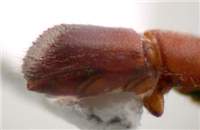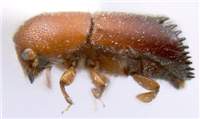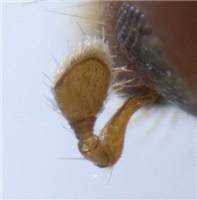Diagnosis
Mid-size species, mostly reddish brown, densely pubescent. Declivity abruptly or obliquely truncated, usually surrounded with row of tubercles. Pronotum elongate, no distinct serrations on anterior edge.
The most common species, T. agnatum, with only obliquely truncated declivity, no row of tubercles, very similar to small Cyclorhipidion spp.
Distribution
Mostly in South Asia and Australasia, one species in Africa.
Biology
The known species excavate a single short tunnel leading to often large terminal brood cavity.
Taxonomy
Described in Hulcr & Cognato (2010). T. agnatum closely resembles some Cyclorhipidion spp.; but molecular analysis doesn't suggest close relatedness (Cognato et al., 2010).
Detailed description
Eyes shallowly to deeply emarginate, upper part smaller than lower part. Antennal club approximately circular, club type two (obliquely truncated, segment 2 visible on posterior side). Segment 1 dominant, covering most of posterior face of club, its margin circular around club, fully costate or mostly costate, may appear softer on posterior side. Segment 2 visible on both sides of club, soft and pubescent, or partly corneous on anterior side. Segment 3 absent from or only partly visible on posterior side of club. Segment 1 of antennal funicle shorter than pedicel, funicle 4-segmented, scapus regularly thick. Frons above epistoma rugged, coarsely punctate. Submentum deeply impressed, shaped as very narrow triangle. Anterior edge of pronotum with no conspicuous row of serrations (serrations no different than on pronotal slope). Pronotum from lateral view elongated, with low summit (type 7), from dorsal view elongated basic shape with rounded frontal margin (type 7). Pronotal disc shining or smoothly alutaceous, with small punctures, often richly pubescent. Lateral edge of pronotum obliquely costate. Procoxae contiguous, prosternal posterocoxal process tall and pointed. Tuft on pronotal basis associated with mesonotal mycangium absent, setae on elytral bases associated with elytral mycangium absent. Scutellum flat, flush with elytra, or miniature, but always visible. Elytral bases straight, with oblique edge, elytral disc longer than declivity, flat, punctures on elytral disc in strial lines (which may be difficult to discern). Elytral declivity differs between T. agnatum, the most common Truncaudum in Asia, and all other Truncaudum spp. In T. agnatum, lateral profile of elytral declivity flat to slightly convex, gradually sloped, dorsal profile of elytral apex rounded. Elytral declivity richly pubescent, often appearing rugose, densely granulate of punctured. Posterolateral declivital costa absent in T. agnatum. Declivity surface with several tubercles on interstriae 1 and 3, often very dense or in form of spines, no tubercles on interstria 2. In all other Truncaudum spp., elytral declivity sharply truncated, mostly surrounded with small pointed granules or large tubercles, and with small tubercles inside declivity in interstriae 1 and 3. The inner surface of declivity shining and opalescent to coriaceous, granulate and conspicuously rugged. The rest of description applies to all species, including T. agnatum. In all Truncaudum, first interstriae parallel on disc but broadened towards apex of elytra, where they sometimes bear tubercles. Protibiae with evenly rounded edge, posterior side of protibia flat, no granules, only setae. Protibial denticles small, bases of denticles not enlarged or slightly enlarged, between 6 and 8 protibial denticles present. Varied shades of reddish brown, darkening towards abdomen. Often richly pubescent. Length: 1.7-3.4 mm.








